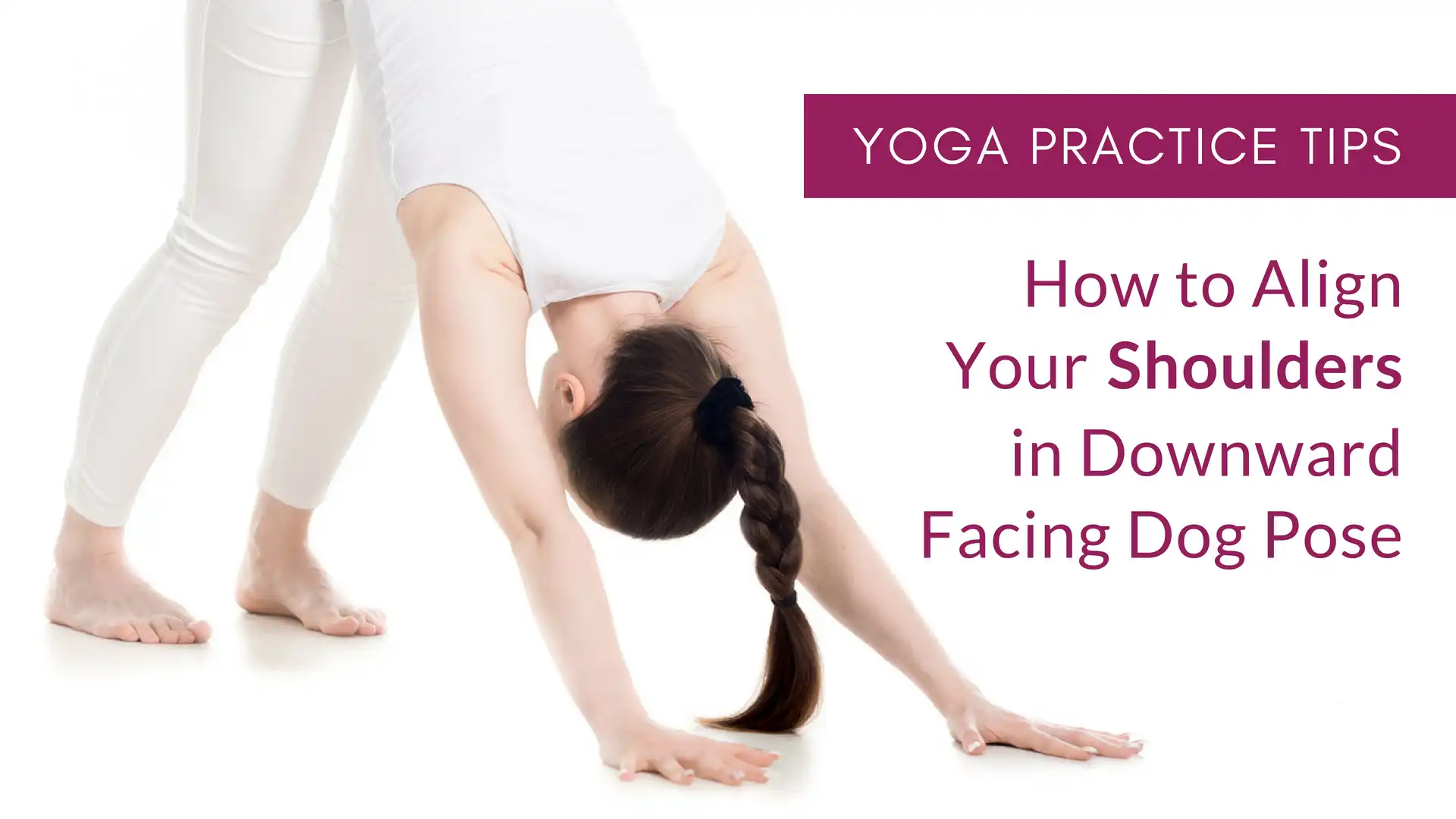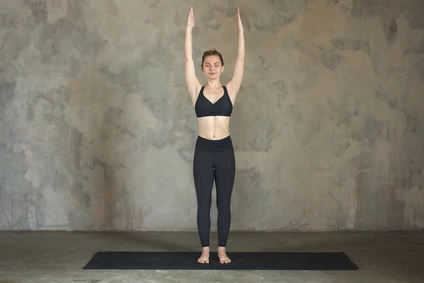Yoga Practice Tips: How to Align Your Shoulders in Downward-Facing Dog Pose

I recently got the following short comment on a post about Adho Mukha Svanasana (Downward-Facing Dog Pose) that I published back in 2015:
“What about shoulders in Adho Muka Svanasana? confused yogi…”
In reviewing the original post’s fairly detailed instructions on how to move into, maintain, and move out of Downward-Facing Dog Pose, I realized that indeed I did not directly address what is happening with the shoulders in this yoga pose.
This was partially intentional, as over the years I have received so many different directions for how to work the shoulder blades/upper back/shoulder joint area that it is challenging to distill them down into something that works for everyone.
In fact, one of the reasons I don’t actually say much about this in my classes is that there is so much individual variability between people that alignment of the shoulders often has to be individualized if you are going to try and address this yourself (or for your students, for the teachers out there).
Taking that into account, I do still have some basic ways of guiding students in Downward-Facing Dog Pose that work well for many people.
How To Focus on Your Arms (Not Just the Shoulders) in Downward-Facing Dog Pose 
What I personally have found to be most helpful is to stress the work of the arms (rather than the shoulders themselves). I recommend pushing your hands strongly down and forward into the mat, as you might push a heavy, tall cart forward, while simultaneously pushing your hips up and back on the diagonal line between your wrists and sitting bones.
Your legs can assist in this backward movement by engaging your leg muscles to create the feeling that they are pulling your hips further back. When those actions take place, your upper back extends into a subtle backbending shape and your shoulder blades naturally spin upward and widen and firm on the ribcage, which, for the vast majority of my students, is a stable, strong, healthy, and non-painful position. For the anatomy geeks out there, the scapulae (shoulder blades) elevate, protract, and upwardly rotate into position.
How To Connect with Healthy Shoulder Blade Positioning In Your Yoga Practice
To get a feeling of the shoulder blade position in a non-weight-bearing position, you can try it in a standing position. Here’s how: 
-
From Tadasana (Mountain Pose), raise your arms into the classic version of Urdva Hastasana (Upward Hands Pose) (photo right) but with your palms facing forward, as they would be for Downward-Facing Dog Pose. (not pictured)
-
Lift your arms as high as they can reasonably and comfortably reach toward the ceiling. Notice the muscles and surrounding tissues around your shoulders that are contracting and/or stretching.
-
Then come down and do Downward Facing-Dog Pose with the same intensity of reach—or push in this position since your hands are on the floor—as you did standing and see if you notice similar responses in your shoulders.
The reason I don’t recommend the instruction to move the shoulder blades away from the ears or toward the pelvis is that I find in many people this tends to jam the shoulder joint—(or more technically, the gleno-humeral joint—where the arm bone meets the shoulder blade). I also don’t recommend the instruction to widen the shoulder blades because this encourages bending the elbows (unless it is also accompanied with an instruction to move them into the reach of the arms).
I developed my instructions over the last 20-plus years of practicing, experimenting with, observing, and teaching this intriguing posture. But I know that there are other good teachers out there who have their own takes on this pose, as well. So it is certainly worthwhile to try out different ways of practicing the pose until you find the combination of actions that provide you with stability, strengthening, and stretching in a healthy and beneficial way.
Yoga Books for Shoulder Alignment in Adho Mukha Svanasana (Downward-Facing Dog Pose)
For some other ideas on how to work with the shoulders in Downward-Facing Dog Pose, you can check out the following yoga books:
-
Light on Yoga, by BKS Iyengar: pg 81-82 of newest addition (note that this version is quite different from my version):
-
Moving Toward Balance, by Rodney Yee with Nina Zolotow, pg. 37
-
Yoga Anatomy, by Leslie Kaminoff, pgs. 176-7
-
Yoga: Awakening the Inner Body, by Donald Moyer, pg. 154
Deepen your practice and learn many healthy aging tips with Dr. Baxter Bell on our premium practice channel.
Study with Dr. Baxter Bell and YogaUOnline – Yoga for Healthy Aging: Curbing Inflammation to Prevent Chronic Disease.
Reprinted with permission from Yoga for Healthy Aging.
 Baxter Bell, MD, C-IAYT, eRYT 500, is a yoga teacher and educator, physician and medical acupuncturist. These days he focuses on teaching yoga full-time, both to ordinary students of all ages and physical conditions and to the next generation of yoga teachers, to whom he teaches anatomy and yoga therapy along with his accessible, skillful style of yoga. Baxter brings a unique perspective to his teaching, combining his understanding of anatomy and medicine with his skill at instructing people from all walks of life and all levels of ability. Baxter is the co-founder and writer for the popular Yoga for Healthy Aging blog, where he shares his knowledge of medical conditions, anatomy, and yoga with practitioners and teachers across the world. In addition to being a frequent presenter at Yoga Journal Alive events and yoga conferences such as IAYT’s SYTAR, he is often quoted as an expert on yoga and health by major national news outlets such as The Washington Post and Wall Street Journal. To learn more, visit www.baxterbell.com, www.yogaforhealthyaging.blogspot.com, and his YouTube channel Baxter Bell Yoga. Baxter is the co-author with Nina Zolotow of Yoga for Healthy Aging: A Guide to Lifelong Well-Being.
Baxter Bell, MD, C-IAYT, eRYT 500, is a yoga teacher and educator, physician and medical acupuncturist. These days he focuses on teaching yoga full-time, both to ordinary students of all ages and physical conditions and to the next generation of yoga teachers, to whom he teaches anatomy and yoga therapy along with his accessible, skillful style of yoga. Baxter brings a unique perspective to his teaching, combining his understanding of anatomy and medicine with his skill at instructing people from all walks of life and all levels of ability. Baxter is the co-founder and writer for the popular Yoga for Healthy Aging blog, where he shares his knowledge of medical conditions, anatomy, and yoga with practitioners and teachers across the world. In addition to being a frequent presenter at Yoga Journal Alive events and yoga conferences such as IAYT’s SYTAR, he is often quoted as an expert on yoga and health by major national news outlets such as The Washington Post and Wall Street Journal. To learn more, visit www.baxterbell.com, www.yogaforhealthyaging.blogspot.com, and his YouTube channel Baxter Bell Yoga. Baxter is the co-author with Nina Zolotow of Yoga for Healthy Aging: A Guide to Lifelong Well-Being.




